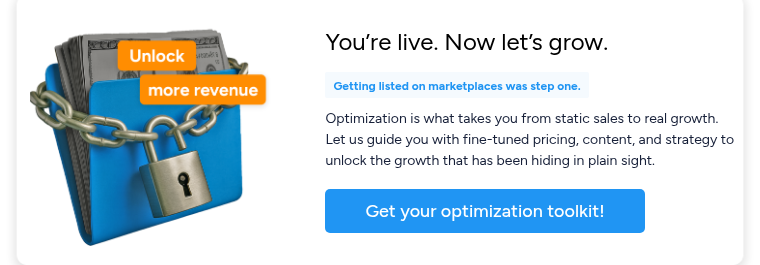Key Takeaways 💡
- Marketplace content quality directly impacts visibility, conversions, and return rates.
- Search-optimized product titles help boost ranking and click-through on marketplace search results.
- Localized, emotionally engaging descriptions build trust and drive higher conversions.
- High-quality, tailored product imagery reduces returns and enhances the shopper experience.
- Understanding your marketplace audience is essential to long-term optimization and growth.
Why invest in marketplace-specific content?
Did you know that the global ecommerce market has reached approximately $6.56 trillion this year? It is expected to expand at a compound annual growth rate (CAGR) of 9.49%, reaching $7.57 trillion by 2027 and surpassing $8 trillion by 2028.
In Europe, ecommerce has remained one of the most dynamic sectors. As of 2024, the market reached $911 billion, up from $887 billion in 2023. Growth is expected to continue, with projections suggesting the European ecommerce market will hit approximately $1.1 trillion by 2026, maintaining a CAGR of 9.5%.
What does this mean? We’ve entered the ‘platform economy.’ Online channels now shape how products are offered and sold. These platforms present sellers with vast opportunities but also significant challenges. One of the biggest hurdles is optimizing product content to ensure long-term returns.
The risk of poor content
- Weak or missing content reduces visibility and conversions
- Poor product details lead to high return rates, costing businesses billions
- Brands waste resources expanding into new marketplaces without fixing underperforming content on their current ones
Investing in marketplace-specific content does more than improve visibility. It enhances the overall customer experience, which builds trust and encourages repeat purchases. High-quality, tailored content also helps reduce costly returns and increases the chances of winning the Buy Box, ultimately driving sustainable growth across all marketplaces.
The new search reality: AI, chat, and marketplace content
Shoppers are no longer just typing keywords into search bars. Increasingly, they’re asking conversational AI tools like ChatGPT, Google’s AI Overviews, or marketplace-native assistants to help them find the right product. This shift is transforming how product content gets discovered.
What does this mean for marketplace sellers?
Marketplace-specific content is no longer just a nice-to-have for SEO. It’s essential for AI visibility. These tools scan structured and unstructured product data to surface recommendations. That includes:
- Titles and descriptions that clearly match user intent
- Comprehensive specs that help AI understand relevance
- Rich media (like A+ content and alt text for images)
- Language that answers common buyer questions directly
In this new environment, content is your signal to the algorithm. If your titles are generic, descriptions are thin, or product data is inconsistent, you risk being excluded from AI-generated recommendations - even if your product is technically live and indexed.
How to optimize your marketplace content in 3 steps?
According to The State of Product Content, 50 % of shoppers abandoned a potential purchase in the past six months due to insufficient product information, while 83 % said they would leave a site entirely without comprehensive content. Additionally, 35 % returned their purchase because the product didn’t match expectations from the information provided. These findings reinforce a clear truth: your product content can make or break a sale.
The good news? Optimizing your content doesn’t require a full overhaul. With a strategic approach focused on relevance, clarity, and marketplace alignment, you can significantly improve your performance, reduce returns, and earn buyer trust. Let’s dive into the three core steps for optimizing your content:
Step 1. Create a search-proof product title
Standing out in the vast sea of online products is every seller's first challenge. Your product title is your gateway to visibility - it must grab attention and rank in search results. But what makes a title effective?
- Align with buyer search behavior: Structure titles to match what potential customers are searching for. Use an order like brand - product name - type - size - key features.
- Follow marketplace guidelines: Each platform has title and data length requirements. Make sure your title fits within these limits.
- Lead with the essentials: Place the most important details, brand, product type, or unique features, at the start of the title.
A great product title not only catches attention but also convinces viewers to click. To streamline title creation, use smart tools like replacement tags. These tools let you update title fields dynamically and apply advanced formatting to meet marketplace requirements effortlessly.
In short, strong titles are your first step to success on any marketplace. Check our blog on how to write product titles that sell. 
Figure 1: Optimized product title for Philips vacuum cleaner from Amazon
Step 2. Create a high-quality product description
A great product description does more than inform; it helps boost conversions. It enhances how customers think and feel about a product.
Here's how to make yours stand out:
- Include all essential details: Ensure your description covers everything a buyer needs to know - features, benefits, dimensions, materials, and more.
- Localize for your region: If you’re selling internationally, make sure your product descriptions and details align with local norms and requirements. Include region-specific information such as metric or imperial measurements, compatible plug types, or regionally relevant compliance certifications. For example, European customers may need CE certification details, while U.S. shoppers will expect details on UL-listed plugs.
- Connect emotionally: Show how your product improves the buyer’s life. Answer questions like: Why does this product matter? How will it make things easier, better, or more enjoyable?
- Tell a story: Don’t just describe; create a narrative. Present your product as part of a solution, a lifestyle, or an experience that resonates with your audience.
- Optimize for each marketplace: Adjust descriptions to meet platform-specific rules. For example, Amazon uses keywords in product descriptions for search rankings. Including keywords here can boost visibility. Bol prioritizes keywords in titles or specs, making descriptions secondary. Tailor yours accordingly.
- Highlight unique selling points (USPs): Use your description to showcase what sets your product apart. On Amazon, you can elevate this with A+ content - extra sections featuring images, videos, and infographics to tell a richer story.
A high-quality product description is more than words - it’s a tool to inspire, persuade, and convert. Tailor it to your audience and platform for maximum impact.
Figure 2: A detailed product description for Philips vacuum cleaner from Amazon
Step 3. Select the optimal product images
Humans are visual creatures, and in ecommerce, product images are often the first thing buyers notice. Studies confirm that visuals strongly influence engagement and purchase decisions.
While often overlooked, high-quality imagery can be a major factor in driving sales.
What makes a great product image?
- High quality: Use crisp, clear images with good resolution, proper lighting, and a neutral background.
- Multiple perspectives: Offer alternative views of the product to help buyers understand every detail.
- Variation images: Include photos for every color or version of the product.
- Consistency: Maintain a uniform style across all images for a professional look.

Figure 3: High-quality, crisp image of a Philips vacuum cleaner from Amazon
Marketplace-specific needs
Different platforms have unique requirements for product imagery. Channels like Otto allow extensive image optimization, while others may take a simpler approach. Always tailor your image strategy to the marketplace you’re using.
Adapt to the product
- For fashion items like shoes or jackets on Zalando or Otto, invest in dynamic, high-quality images to enhance customer experience.
- For items like books on Amazon, focus on features like a compelling synopsis, as additional views might not be as impactful.
How imagine.io can help
- Create High-Impact Visuals to Win the Digital Shelf: Create 3D renders, augmented reality (AR) viewers, 3D product configurators, 360° spins, product video, and more to showcase products with precision and creativity.
- Enhance Customer Experience: Dynamic visuals help buyers imagine your products in real-world settings, boosting engagement, and conversions, and reducing returns.
- Save Time and Money: Skip traditional photoshoots. With imagine.io, create stunning assets quickly and cost-effectively, keeping up with trends and adapting fast.
Best practices
Finally, always adhere to general marketplace guidelines for product images. High-quality, optimized visuals combined with tools like those from imagine.io can set your products apart, creating a seamless and engaging shopping experience.
Bonus tip: Understand your marketplace audience
Content optimization starts with knowing your audience. The better you understand them, the better you can create a seamless and engaging shopping experience. While platforms like Amazon, Rakuten, eBay, and Google offer tools to gather shopper insights, navigating this overwhelming landscape can be challenging.
That’s where ChannelEngine comes in.
We’re the marketplace experts, here to simplify your journey. Instead of managing multiple tools and deciphering complex data on your own, let us guide you. Our expertise helps you:
- Prioritize your top 20% of products that drive 80% of revenue.
- Optimize product content for any marketplace.
- Put a dynamic pricing strategy in place.
- Understand shopper behavior across platforms.
- Craft strategies tailored to maximize visibility and conversions.
- Make informed decisions without juggling multiple tools
Beyond content: Continuous optimization
Optimizing content is the first step. To unlock further growth:
- Review existing channels and focus on hero marketplaces
- Monitor Buy Box performance and implement repricing strategies
- Use A/B testing to refine content and promotions
- Automate workflows to free up time for strategic decisions
- Apply localized SEO for international marketplaces
This cycle of review, test, and adapt turns stagnant listings into consistent revenue drivers. Marketplace optimization is key to long-term success. Before branching out to new platforms, ensure you’re fully leveraging the potential of your existing ones.



.png?width=360&height=202&name=Marketplace%20Talk%20Nov2025%20(2).png)

